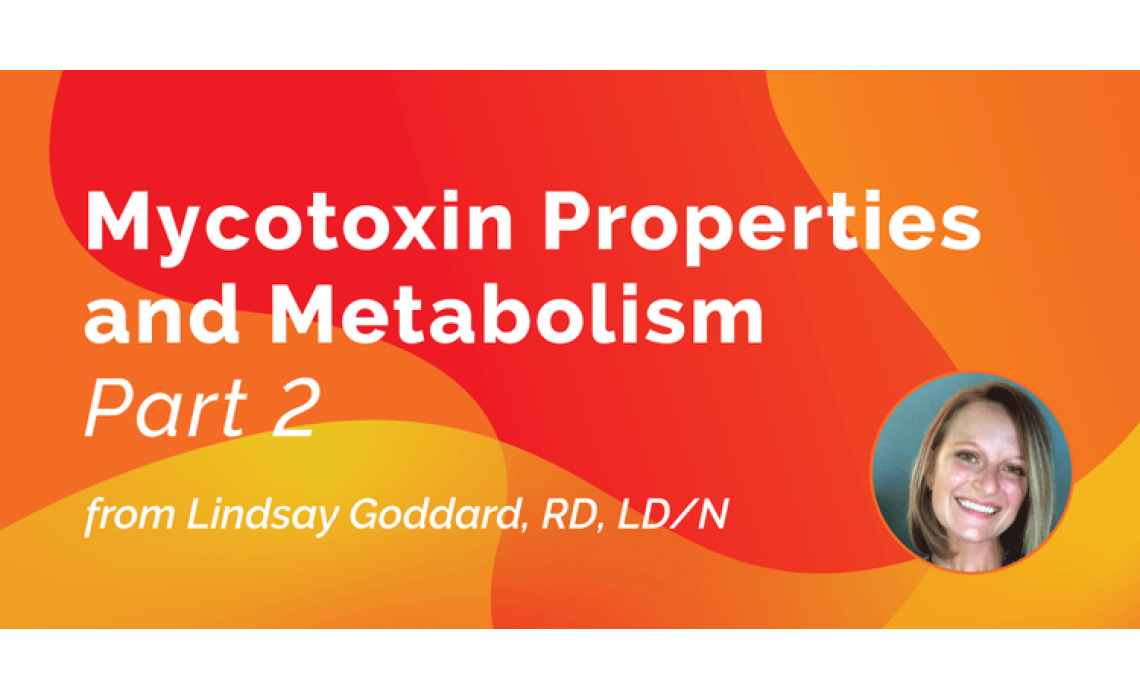MYCOTOXIN PROPERTIES AND METABOLISM: PART 2

As a mycotoxin classified under the Aspergillus category, Gliotoxin has an average elevation range for people who are suspicious of mycotoxins between 200-2000 ng/g of creatinine. More extreme cases have been shown to be in the 20,000-25,000 ng/g of creatinine range. Although Aspergillus (particularly the fumigatus species) and Penicillium have been shown to produce Gliotoxin, some yeast can as well, particularly Candida (1). A study that looked at A. fumigatus strains from silos contaminated with mold found only 11% of the cultures to be gliotoxin producers (2). On the other hand, a study performed at MD Anderson Cancer Center, found 93% of A. fumigatus strains from respiratory and tissue samples produced gliotoxin (3). Other studies that compared environmental versus clinical A. fumigatus producing gliotoxin, have not only found geographical variations, but overall as the evidence suggests, it is found more commonly as the result of internal colonization rather than contaminated environmental sources (4). Gliotoxin is also commonly found in the soil, but in that case, it is most commonly produced by Trichoderma virens to support competition among the other fungus and bacteria (4).
TOXICOLOGY
Gliotoxin has been shown to inhibit phagocytosis by neutrophils and transcription factor NF-kB, causing immunosuppression, which can potentially further influence cytokine production and mast cell degranulation (5,6). Apoptosis in monocytes and dendritic cells has also been observed. Research has also demonstrated that gliotoxin can inhibit NADPH oxidase and Glutaredoxin enzymes, influencing the system’s ability to tolerate oxidative stress (7). Other studies on laboratory mammals have found that gliotoxin exposure causes a decrease in blood pressure, gastrointestinal hypermobility, and altered sleep patterns (8,9). It has also been identified as a potent antiviral, antibacterial, and anti-fungal agent (e.g. Rhizoctonia solani, Botrytis cinerea, Colletotrichum spp., Pythium ultimum, Fusarium spp (10).
PROPERTIES
Gliotoxin is a compound from the epipolythiodioxypipeazines family, which includes an internal disulfide bridge. It is this disulfide bridge that allows the cross-linkage with cysteine residues, which produces reactive oxygen species (11). It can be produced by A. fumigatus near the temperature of the human body at around 37 degrees Celsius (98.6 degrees Fahrenheit), which is unique for mycotoxin production (12). Gliotoxin has a melting point between 200 °C and 202 °C (392-396 °F) and has a solubility of 0.5-5 mg/L depending on the solvent, where organic solvents increase the solubility (13). Stability increases in acidic, dry environments, but Gliotoxin is extremely unstable and degrades quickly in alkaline and neutral environments with high moisture. There is little literature regarding the half-life of gliotoxin, however, a soil study found the half-life is highly variable and dependent on pH and moisture. In acidic conditions (pH 4), gliotoxin was stable for >30 days, but in alkaline water (pH 7.5), only 35% was stable on the 10th day of measurement. However, when in dry soil versus moisture-rich soil, regardless of pH, gliotoxin was completely degraded on the 10th day (10).
METABOLISM
There is limited data on the pathways utilized by gliotoxin in the human system. However, we do know that it can enter the cytoplasm of the cell, which can arrest the cell cycle possibly by interfering with DNA (9). Its oxidized disulfide structural form allows for glutathione conjugation which reduces it to the dithiol form. This is how it is taken up into the cell and increases its accumulation (9, 14). This reduced form is how it is generally found in the cells, and there is a maximum concentration allowance dictated by cell density. When glutathione levels decrease, the oxidative intracellular toxin creates an increased outflow from the cells, allowing for minimal amounts to have more of an impact (14). As it moves through the system, through the kidneys for elimination, it has been documented to be highly cytotoxic to renal epithelial cells at lower concentrations (9).

Similar in structure to aflatoxins, particularly B1 (15), Sterigmatocystin (ST) is most commonly produced by Penicillium and Aspergillus (mainly A. Versicolor and A. nidulans), but can also be produced by Fusarium, Bipolarisand even Stachybotrys and Chaetomium (16, 17). It is not currently monitored in food due to the lack of occurrence. Stored cheese and grains are the only documented contaminated circumstances and there have been no outbreaks associated with ST reported to date (16). It is mostly associated with being a potent liver carcinogen (18). The data was limited on ST, and information was difficult to obtain.
TOXICOLOGY
ST has been found to be highly carcinogenic because it can easily react with DNA and be highly mutagenic. However, this only applies to the exo-epoxide formed post conjugation through phase II detoxification. The endo-epoxide has been shown to be less reactive (18). This is one reason it is said to be less toxic than Aflatoxin B1. It has been documented in mice to be hepatotoxic, with chronic and consistent exposures, and with mutagenic actions (16). Also known to increase production of reactive oxygen species, with enhanced lipid peroxidation (16).
PROPERTIES
ST contains a dihydrofurofuran core, with a xanthone nucleus, and an attached bisfurn structure (16,18). It is insoluble in water, with a half-life in plasma of 46.5 to 55.8 hours and a melting point of 246 °C (474 °F) (19).
METABOLISM
ST goes through cytochrome P450 oxygenase systems, which produces endo and exo-isomers. They are incredibly unstable, and so they are difficult to isolate from biological systems, hence measuring the toxin itself is likely more efficient than measuring the metabolites generated from metabolism (18). Human studies are limited. However, rodent studies have found the greatest tissue distribution resided within the gastrointestinal tract tissue with 100% elimination in 96 hours, 80% excreted in the first 24 hours in urine (19). Although, when tissue accumulation was compared to blood levels, they remained significantly higher in the tissue, though still with decreasing levels by a factor of 8 over 96 hours. This makes sense because ST also goes through enterohepatic recirculation via the bile, which is likely why tissue amount is extended over serum and urine (19).

Both Roridin E and Verrucarin A mycotoxins categorized under the Stachybotrys mold, are relatively similar, though differences will be discussed as they arise. Roridin E is produced by Fusarium, Myrothecium, Trichothecium, Stachybotrys, and less commonly, the Betula cordifolia (the mountain paper birch tree) and the Podostroma cornu-damae mushroom (20, 21). Verrucarin A is also produced by Fusarium, Myrothecium, Trichoderma, and Stachybotrys, but differs in that Trichothecium, Cephalosporium, and Verticimonosporium can also produce it. Though not as common to come up positive on the testing, these are some of the more toxic mycotoxins measured. When exposed to trichothecenes the effects can be quite toxic. For Roridin E; irritation of the skin, mucosal layers of the intestines, and the nasal passage have been observed, sometimes leading to blisters and bleeding. Ocular symptoms have been described as burning, blurred vision, conjunctivitis, and pain. Hypotension, nausea, vomiting, and potentially shock have also been documented (22). Symptoms can be variable for Verrucarin A, but can be extreme and have cascading effects. The symptoms include bone marrow damage, nervous disorders, cardiovascular alterations, hemostatic derangements, immunodepression, gastric inflammation and lesions, anorexia, and dermatological lesions potentially leading to necrosis (23,24).
TOXICOLOGY
Trichothecenes are different than other mycotoxins in that they do not require metabolic activation, rather they react with biological systems, directly. Exposure can be through oral, dermal, inhalation, and parenteral routes, and once absorbed, they are able to move across the plasma membrane freely (22,23). Roridin has been shown to inhibit receptor tyrosine kinase, impact glucose-6-ph,osphatase in liver tissue, and also deplete glutathione (20, 25). One of the major components of Verrucarin A’s toxicity is their ability to bind to ribosomes, particularly at the 3’ end of large 28S ribosomal RNA. This inhibits initiation, elongation, or termination steps, therefore influencing protein synthesis and polyribosomal disaggregation (23). These mycotoxins can alter membrane structure, influencing the mitochondria, and have also been noted to inhibit RNA and DNA synthesis along with mitosis. Verrucarin A is known as a potent antibacterial and antifungal (23).
PROPERTIES
Trichothecenes, including these two mycotoxins, contain a distinct 9,10 double bond, and a 12,13 epoxide ring, with an additional hydroxyl or acetyl groups at certain positions (20, 22,23, 26). They are lipophilic in nature but have a relatively short half-life. It is estimated that trichothecenes, in general, have a half-life of minutes to hours (27, 28). Both have low water solubility, with Roridin E at 0.01 g/L and Verrucarin A at 0.043 g/L (22, 23). There is no data on melting points for either one of these toxins.
METABOLISM
Once absorbed into the system, they are metabolized in the liver by cytochrome P-450 enzymes and trichothecene-specific carboxylesterases. Through phase II detoxification, the major pathway utilized is glucuronidation and deepoxidation (22,23, 27). They are mainly excreted through urine and feces, but additional data beyond these pathways was difficult to find. One study that was done on a similar trichothecene produced by S. Chartarum, Satratoxin G, found that it was detectable in the blood of the mice being exposed intranasally from 5-60 min after exposure (26). Noting that the clearance from plasma was rapid and single compartment kinetics was observed. The highest concentrations were found in the nasal passage (480 ng/g), then the kidneys (280 ng/g), lungs (250 ng/g), and spleen (200 ng/g) had the next elevated amounts. Interestingly, the liver did not have as high of a concentration (140ng/g). The half-lives were variable in the tissues as well, with 7.6-10.1 h in the nasal passage and the thymus, and 2.3-4.4 hours in the other organs. When the urine and feces were evaluated, the cumulative excretion over 5 days was 0.3% of the total dose administered. The two mycotoxins were difficult to compare but do give some insight into the biochemical pathways of these toxins (26).

Ennaitin B comes from the fusarium species, and though it is common in foods due to its resistance to food processing techniques, and being unregulated, it has also been found in water damaged buildings (29). It has been shown to be more toxic than Ennaitin A, and just as common in our environment (29). Research has shown it acts as an antibacterial (particularly to certain species of Escherichia, Enterococcus, Salmonella, Shigella, Listeria, Yersinia, Clostridium, Psuedomona, and Staphylococcus), and antifungal (Beauveria and Trichoderma) (29, 30).
TOXICOLOGY
ENN B is most commonly known to inhibit acyl-CoA and cholesterol acyl transferase activity, which will inherently influence lipidemic levels, particularly with decreased free fatty acid availability and triglyceride biosynthesis (29). EEN B has also been shown to affect the mitochondria directly by influencing potassium uptake and decreasing calcium retention capacity of the matrix. This can cause the mitochondrial membrane potential to collapse. Cell cycle disruption, and apoptotic death, have also been observed with the presence of ENN B (31). Adrenal endocrine influences via reducing progesterone, testosterone, and cortisol have been noted even in smaller amounts (29, 32). Higher concentrations (10 µM) were noted to reduce testosterone and estradiol (33). It has been shown to be a potent cytotoxin in several human and animal cell lines, even at very low levels. This is amplified when other mycotoxins are present (29).
PROPERTIES
ENN B is a cyclohexadepsipeptides that is composed of mostly valine, isoleucine, and leucine residues, and three hydroxy acids, usually hydroxyisovaleric (29, 31, 34). It is lipophilic in nature, giving it the ability to incorporate into the phospholipid bilayers of the cell membrane. They are ionophores, which allows them to have a lot of other variabilities in their activity (29). This leads to its ability to influence the selectivity of the pores and disrupt cation levels. Also, it has the ability to form complexes with alkali metal ions, with selectivity in the following order: K+ > Ca2+ ≥ Na+ > Mg2+ > Li+. Solubility is 0.018 g/L in water (31). With regards to half-lives, a study that evaluated the degradation rate within a human gastrointestinal tract model found a degradation rate of 79 ± 5% within the GI tract, with even more degradation of enniatin B in the colon after 24 hours (35). The melting point is 229°C (444 °F), which is the main contributing factor as to why it is not affected by food processing (31).
METABOLISM
ENN B enters the system via oral, dermal, or inhalation route. From the aforementioned study on the GI model and ENNs behavior, they found metabolites from ENN were adsorbed within the GI tract (more than the parent compound) and observed moderate blood-brain-barrier crossing (35). It has been noted to bioaccumulate in the lipid tissue in rats and disseminate throughout the tissue in chickens (29). It utilizes the P450 enzyme CYP3A4, which to note, is one of the main enzymes that metabolizes numerous drugs, and other contaminants (31,36).

Chaetoglobosin A is one of the most toxic mycotoxins on the test with even small amounts being deadly. It is very common in water damaged buildings, and in fact, one study that looked at the prevalence found that out of 794 water- damaged building material, 49% had isolated Chaetomium species (37). Chaetoglobosin A is one of the major mycotoxins produced by the Chaetomium species (mainly Chaetomium globosum) and some Penicillium species (38, 39). There are 18 natural chaetoglobosin mycotoxins that have been identified and have been known to be an antimicrobial agent with some neocicidal and antifungal influences (40, 41). Unfortunately, the literature is sparse on this mycotoxin, and details regarding properties and metabolism were limited.
TOXICOLOGY
Chaetoglobosin A has been shown to influence cell division by inhibiting cell movement, cytoplasmic division, and multinucleation (40). It has also been found to be a P450 inhibitor and influence apoptosis (40, 42). Research has shown it to be quite toxic to mammals. In rats, exposure by injection caused necrosis of the thymus and spleen, and degeneration of the spermatocytes (40). Evidence also suggests it to be cytotoxic, particularly in cancer cells, and influences the cytoskeleton, accompanied with apoptosis (40 and 41). There is evidence of it being teratogenic in mice fetuses, with documented skeletal malformations, micromelia of the forelimbs, fused ribs, and death (43).
PROPERTIES
Chaetoglobosin A is a member of the cytochalasan-type (48). All 8 types have a similar 13-member macrocycle and perhydroisoindole skeleton, with an indolymethyl substituent on C-3, but vary in oxidation level, C-11 and C-12 methyl substituents additions (40). They have a melting point of 165°C-170°C (329°F - 338°F), but no data was available on solubility or half-life at this time (40).
METABOLISM
The data is very limited on the metabolic pathways of Chaetoglobosin A in the animal system, with in vitro studies very much lacking in the literature. A dated study in 1978 found higher toxicity load through parental exposure versus oral dosing in rats and mice, alluding to low oral absorption (44). In this study, when the rats were injected with this mycotoxin, death was observed 10 minutes to 2 hours post-administration, with visceral congestion noted on autopsy (44). At lower injection doses, 36% mortality rate was observed in 6-48 hours accompanied by necrosis throughout the spleen, decreased thymocytes, spermatocyte degeneration, and pulmonary congestion. The other 64% that recovered, after 3 days, the only effects were on the thymus and testes, with no histological abnormalities after 7 days (44). In another study where the rats and mice were fed an oral diet contaminated with a 50% concentration of Chaetoglobosin A for 10-15 days, decreased weight was observed (38).
This concludes the evaluation of each mycotoxin on the MycoTOX Profile. Hopefully, it helps in the understanding of these mycotoxins in nature, and potentially in our bodies.



